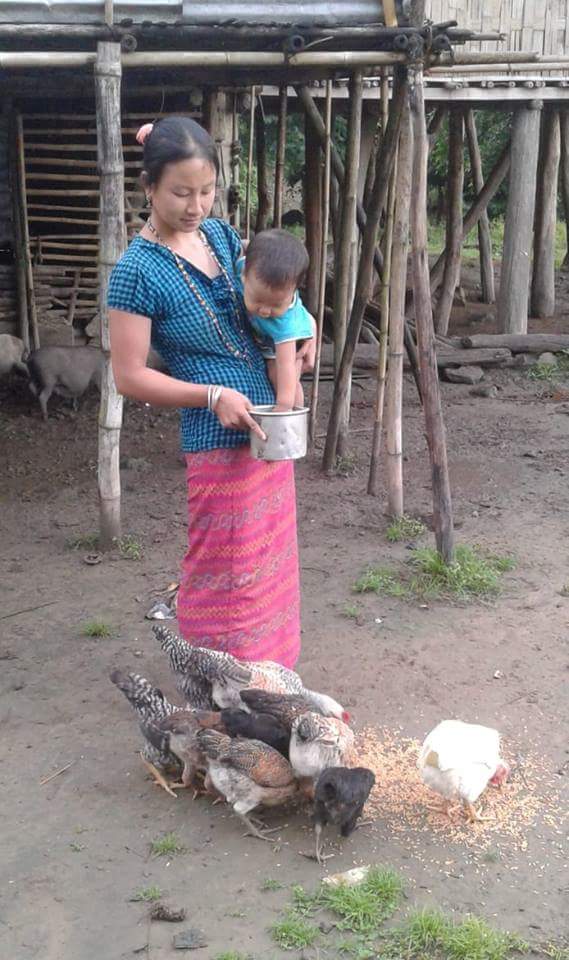
It was very early in the morning when the call came. Minoti Chakma was in labor, and her husband knew something was not right.
She had been in pain for a while. The midwife and the family elderlies were trying to help her deliver the baby, a common practice in that remote indigenous community in the Chittagong Hill Tracts (CHT) of Bangladesh.
But nothing seemed to be working, and Minoti’s husband grew worried.
So, he decided to seek help from a person known locally as the ‘nutrition trainer .
The trainer he met is part of a larger team of twenty-two who raises awareness about nutrition and hygiene among indigenous communities in the Banderban and Rangamati districts.
With support from the South Asia Food and Nutrition Security Initiative (SAFANSI), the nutrition trainers visit families in selected villages, gather women and men into groups, and show them instructional videos.
These low-cost videos introduce communities to best practices in nutrition and health—and challenge long-held social and cultural norms . An open discussion usually follows the projection.
In Minoti’s case, the videos worked.
Even though neither Minoti or her husband attended the nutrition film sessions, they knew from their neighbors what they were about: caring for pregnant women.
In Minoti’s community, pregnant women are encouraged to keep on working until full term, even performing strenuous tasks like carrying weighty items.
Families do not provide extra nutrition and care required for the healthy development of the fetus and the wellbeing of the mother.

Too often, women are expected to work throughout their pregnancy as this will ease and shorten the delivery.
Eating ‘too much food’ is frowned upon and is said to make the baby bigger in the uterus leading to a painful and difficult delivery.
The videos, acted by women and men speaking in Chakma and Marma languages, present a different outlook.
They cover such topics as good health and hygiene and highlight the importance of regular check-ups and deliveries in local health centers.
Upon viewing the videos, community members become more familiar with the importance of breastfeeding newborns, vaccinating their children, and giving solid food to babies of six months of age and over .
Audiences also learn what kind of care and nutrition is required for pregnant and lactating mothers, such as washing their hands, using toilets, cooking a nutritious one-dish-meal and eating locally available nutritious foods.
The actors also urge viewers to seek professional medical help whenever necessary.
A recommendation that Minoti’s husband took to heed, thus disregarding long established local norms.
Minoti’s family lives in a rugged hilly area miles away from the closest health center.
In the absence of any transportation and with minimal resources, the nutrition trainer immediately arranged a ‘human ambulance’ by laying Minoti on a bedsheet carried by four men.
They carried her through the hills for almost seven hours to the health center. There, she gave birth to a healthy baby .
While not a direct project participant, Minoti benefited from the knowledge the community had gained from the video, which in turn they shared with their friends and families.
And in remote communities with few public services, simple yet innovative videos can go a long way to change behaviors .
On top of that, trainers come from local indigenous communities, speak the same language as the participants, and understand their practices and beliefs.
This cultural proximity allows the trainers to maintain informal communications with the participants regarding any query or support they need .
Related Video Resources:
- Lactating Mother's Additional Nutritious Food and Colostrum https://www.youtube.com/watch?v=NzUS9K8aYsc
- Pregnant mother care and nutrition (Marma language) https://www.youtube.com/watch?v=ZXT2CEKflN8
- Locally Available Nutritious Food and Khichuri (Chakma Language) https://www.youtube.com/watch?v=wjfUItsEMbI
- Locally Available Nutritious Food and Khichuri (Marma language) https://www.youtube.com/watch?v=zOT7IYEPjlk&t=2s
- Child diseases and prevention https://www.youtube.com/watch?v=Qshz2rCaaM0
- Supplementary Food for Children from Six months of age https://www.youtube.com/watch?v=QhQjRhICCVc


Join the Conversation